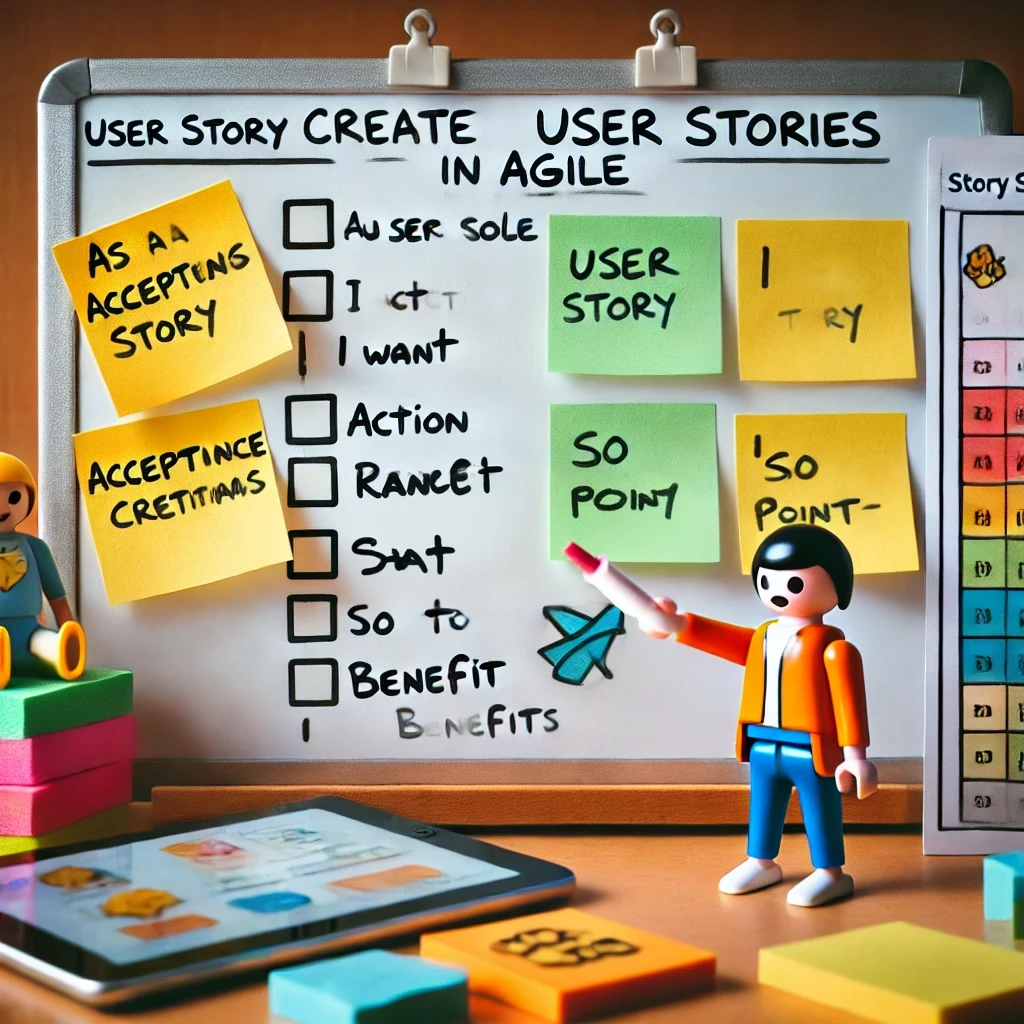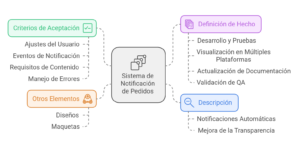
In the agile methodology, the user stories are key tools for transforming ideas into concrete, high-impact results. But what makes these stories so powerful and, above all, how do you make user stories with impact?
In this article, we explain how to structure them with practical examples and their integration into frameworks such as Scrum and Kanban. Let’s get started.
What is a User Story in the Agile Methodology?
A user story is a short and simple description of a feature that a user needs, written from their perspective. It is most often structured by answering these three essential questions:
- Who?Who is the user who needs this functionality?
- What?What do you need to achieve? That is, what functionality do you require?
- Why?What is the value of meeting this requirement? What does the user/product gain from this new functionality?
Let’s take an example of an online ordering APP:
“As a customer, I want to receive notifications about my orders so I am aware of their status.”
- Who? The customer (the user)
- What?: Receive notifications of the orders I have placed
- Why?: To know the status of my orders (i.e. to know when they will arrive)
User stories are fundamental to foster collaboration, as they act as a bridge between development teams and stakeholders. development teams and stakeholders, ensuring that everyone understands the needs and is working towards the same goal.
Difference between User Story and Epic in Agile
Now that we know what a user story is, let’s see what epics are and the differences between them in agile environments. They have different purposes:
- User StoryUser Story: It is a small, actionable unit, that fits inside a sprint. It responds to a specific user need.
- EpicIt is a higher level that groups larger functionalities (or sections), serving a general theme. It contains multiple user stories within it as well as other artifacts (tasks, spikes…).
Let’s see it with an example:
- EpicOptimizing the online shopping experience” : “Optimizing the online shopping experience”.
- User Stories
- US-1: “As a customer, I want to receive notifications about my orders so that I am aware of their status.”
- US-2: “Allow users to save products to a wish list.”
- US-3: …
And here is a visual example

Key elements and format of a User Story
We have already seen that a User Story (US, or user story as well) needs, at least, a title in the following format:
“How [user role], I want [action or need] for [benefit or purpose].”
This is a very common structure, but not mandatory. You can evolve it according to your needs to make it more useful. What a user story must have, apart from a titleIn addition to the title, there are several key elements to make it a success.
- Description: This functionality will allow customers to receive automatic notifications (via email, SMS or app) on the progress of their orders, improving transparency and user experience.
- Acceptance criteria (or acceptance criteria): They detail how to tell if the user story is complete. Example:
- Users can activate voice search.
- The system recognizes basic commands such as “look for red shoes”.
- Definition of Done (DoD): Defines the minimum requirements for completion, such as functional testing and documentation.
- Other elements: Depending on the casuistry of the story, elements such as:
- Designs: Images, screen diagrams, layouts. UX… any visual material that helps to better understand (and develop) the User Story.
- Technical requirements: Details of any technical elements to be met by the US.
These key elements will help everyone reviewing the user story to understand clearly and specifically what functionality needs to be performed, the immediate value to the end user, and what it must accomplish to be completed (and useful to the user).
Let’s see it in the example we are working on:
“As a customer, I want to receive notifications about my orders so I am aware of their status.”
- Description: This functionality will allow customers to receive automatic notifications (by email, SMS or app) about the progress of their orders, improving transparency and user experience.
- Acceptance Criteria:
- Users should be able to enable or disable notifications from their account settings.
- Notifications must be sent in the following events:
- Order confirmed.
- Order on the way.
- Order delivered
- The content of the notifications should include the order number, the current status and a link to further details.
- In case of errors in the submission, the system must register the incident for review.
- Definition of Done (DoD)
- The functionality has been developed and tested in a test environment.
- Notifications are displayed correctly on all three platforms (email, SMS and app).
- The technical and user documentation has been updated.
- The QA team has validated all acceptance criteria.
- Other Elements
- DesignsMockups of the emails and notifications in the app.
- UX requirements:
- Notifications should be visually appealing, with a clear and legible design.
- Clear buttons for the user to “View details” or “Disable notifications.”
- Technical requirements:
- Integration with a messaging service (such as Twilio for SMS or Firebase for push notifications).
- Logging of shipment logs for diagnostics.

User Stories in Scrum and Kanban
Workflow Integration
In Scrum, user stories are added to the Product Backlog, where the Product Owner prioritizes them according to the value they bring to the user and the business. During sprint planning, the team selects those stories that are actionable and achievable within the sprint. These stories should be well defined, with clear acceptance criteria and a manageable size. If you want to learn more about how to manage the product backlog, I recommend you this article Product Backlog Management
In Kanban, user stories flow continuously across a board divided into columns such as “To Do”, “In Progress” and “Completed”. This approach makes it possible to visualize the work in progress and better manage bottlenecks. User stories should move smoothly, ensuring that each column has a work-in-progress (WIP) limit to maintain efficiency.
Assignment of Story Points in Agile
The story points are a key metric in Agile for estimating the effort required to complete a user story. They do not represent time, but complexity, uncertainty and amount of work required. For example, a simple story might be worth 2 points, while a more complex story such as “Integrate card payment” might be assigned 8 points. Story points are assigned on a Fibonacci scale. Want to improve your story point estimation technique? Here are some useful tips for agile teams. Story points not only help to better plan sprints, but also foster important discussions within the team, aligning expectations about the scope and complexity of the work.
Tools and Best Practices
There are many tools that make it easier to work with user stories, such as Jira, Trello o ClickUp. These platforms allow you to organize stories, assign tasks and track progress visually and efficiently.
Importance of Conversation and Feedback with Stakeholders
A good user story doesn’t end when it’s written; its true value lies in the conversations it generates. These interactions are critical to ensure that stories reflect real needs and prioritize what brings the most value to both the user and the business.
Why is it key to involve stakeholders?
- Ensure alignment: Stakeholders (customers, key users or interested parties) know the user’s context and needs best. Including them in the process ensures that user stories address the right issues.
- Avoid misunderstandings: A story may seem clear on paper, but without conversations, expectations can diverge. A good dialogue clarifies doubts before development begins.
- Adjust priorities: Market needs change. Listening to stakeholders allows you to identify necessary adjustments before investing time in low-impact tasks.
Practical example of feedback
Suppose the technical team suggests simplifying a feature to speed up development, such as limiting order notifications to email only.
- Stakeholder feedback: The stakeholder can highlight that 60% of users prefer push notifications on their mobile, which makes removing this option negatively affect the user experience.
- Result: Thanks to the conversation, the team adjusts the story to include push notifications as a priority, ensuring that the functionality meets end-user expectations.
Conversation as a continuous cycle
User stories are a starting point, not a rigid contract. Through constant feedback:
- Details and acceptance criteria are clarified.
- Possible dependencies or blockages are identified before starting work.
- The results are validated once the history has been completed.
This iterative approach fosters greater collaboration, reduces the risk of errors and ensures that the final product meets real market needs.
Conclusion
The user stories are an essential tool in the agile methodology to connect the team with the real needs of the user. By structuring them correctly and integrating them into frameworks such as Scrum or Kanban, they facilitate planning and ensure a focus on value.
Beyond writing them, their real impact lies in the conversations they generate. Engaging stakeholders ensures that each story reflects clear priorities and is aligned with business objectives.
Start by applying these techniques and tailor user stories to your team’s needs. With a collaborative and agile approach, you will transform ideas into features that will make a difference.



